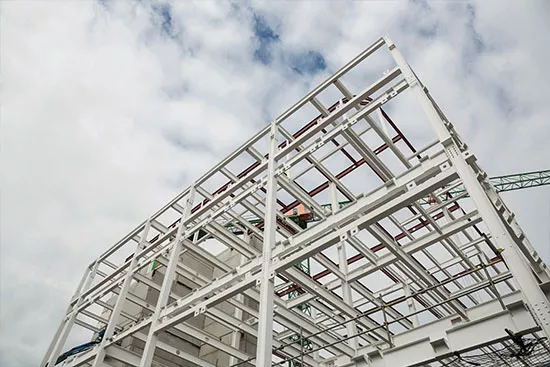Portal frame analysis
Need a portal frame calculation?
The calculation of a metal portal frame refers to the engineering process through which the necessary dimensions and structural characteristics are determined to design a frame made of steel. This frame consists of rigid components such as columns and beams, capable of handling and withstanding the various loads and forces that will act upon it throughout its service life.
The primary objective of calculating a metal portal frame is to ensure its stability, safety, and load-bearing capacity. To achieve this, principles of structural mechanics are applied, along with knowledge of material strength, stress and strain analysis, as well as advanced engineering methods.
Process of calculating metal portal frames
Material selection
Load analysis
The process of calculating metal portal frames begins with a thorough analysis of the loads that will act on the structure. These include dead loads (the weight of the structure itself), live loads (movable loads such as people and equipment), as well as seismic and wind forces. Using structural engineering methods, the magnitudes and directions of these loads are determined.
Structural modeling
Member sizing
Importance of calculating metal portal frames
- Structural Safety: Proper calculation ensures that the metal portal frame can withstand the loads and forces it will be exposed to during its service life, preventing collapses or damages that could endanger lives and cause significant material losses.
- Efficiency in Material Usage: By accurately calculating and sizing the structural elements, material waste is avoided, resulting in a more efficient construction process and reducing associated project costs.
- Economy and Cost-Effectiveness: Optimal calculation allows for the design of metal portal frames that meet load requirements without the need to oversize structural elements, helping to reduce the total project cost.
- Regulatory Compliance: The calculation is carried out following the current standards and regulations at the construction site, ensuring that the structure complies with safety standards established by relevant authorities.
- Design Optimization: Through structural analysis and modeling, areas for improvement in the portal frame design can be identified, allowing for adjustments to achieve a more efficient and functional structure.
- Resistance to Variable Loads: The calculation considers various loads such as dead loads, live loads, seismic loads, and wind loads, ensuring that the portal frame can withstand different loading scenarios while maintaining its structural integrity.
- Durability and Service Life: Proper calculation ensures that the metal portal frame is designed to withstand the passage of time and environmental conditions, prolonging its service life and reducing the need for frequent repairs and maintenance.
- Environmental Sustainability: By accurately designing metal portal frames, excessive material usage is avoided, contributing to greater sustainability and reducing the environmental impact of construction.
Contact us
Basic information on data protection
Responsible: Cero Metros Cuadrados, S.L.
Purposes: Manage the sending of information that you request. Sending commercial communications.
Legitimation: Consent. You can withdraw consent at any time.
Recipients: Your data will not be transferred to third parties except in case of legal obligation.
Data subject's rights: To access, oppose, rectify and have their data deleted, as well as other rights as explained in the additional information.
You can access additional and extended information at this link.



